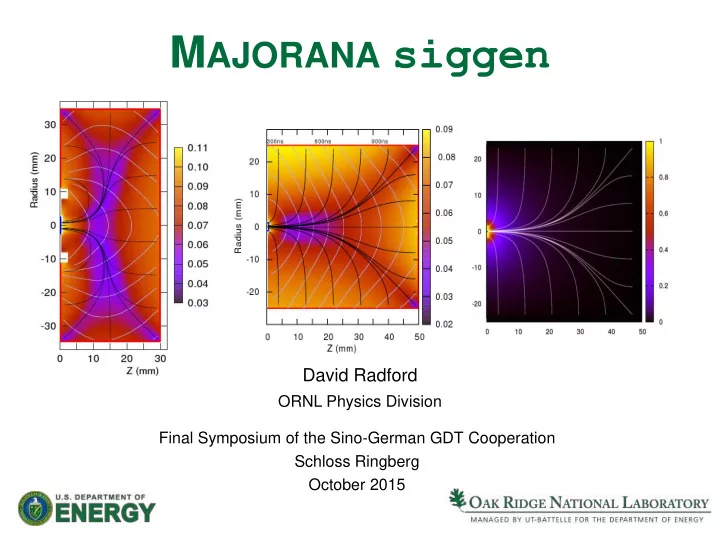

M AJORANA siggen David Radford ORNL Physics Division Final Symposium of the Sino-German GDT Cooperation Schloss Ringberg October 2015
Outline • Overview of fieldgen and siggen • New capabilities • Capacitance • Charge cloud sizes • Mobilities • Li transition layer 2 Managed by UT-Battelle for the U.S. Department of Energy
MJD_fieldgen and MJD_siggen For CANBERRA (BEGe) and ORTEC PC detectors • Require cylindrical symmetry in detector geometry • Both programs use a common 2D grid (r, z) for field and weighting potentials Recent major updates • One common configuration / geometry file for fieldgen, siggen • Include effects of charge cloud size, diffusion, and repulsion on the signal shapes • Code reorganization for easier multi-threading Code is open source, freely available: svn://radware.phy.ornl.gov/MJ/mjd_siggen 3 Managed by UT-Battelle for the U.S. Department of Energy
MJD_fieldgen and MJD_siggen Config file fieldgen • Detector geometry • Impurity profile Electric potential GEANT • Grid size Weighting • Temperature potential(s) • File names • Charge cloud Input options siggen • … interaction (stester) locations (energies) Signals 4 Managed by UT-Battelle for the U.S. Department of Energy
MJD_fieldgen Calculation of electric and weighting potentials • Stand-alone program • 2D relaxation, using cylindrical symmetry • Simplest boundary condition for passivated surface; parallel field • Does not try to include material outside the crystal • Automatic adaptive grid (coarse -> finer -> finest) to speed up calculation • Typically use 0.1 mm grid for MJD PPCs • Attempts to deal with partially filled voxels • Properly handles undepleted volumes • Iteratively finds undepleted voxels and sets their space charge to zero • Calculates capacitance of readout contacts 5 Managed by UT-Battelle for the U.S. Department of Energy
Depletion • Should always use measured/calculated depletion voltages to validate or adjust the impurity concentration in the config file • Good and bad PPCs; 100V per step Head Tail Tail Head 6 Managed by UT-Battelle for the U.S. Department of Energy
Depletion • Segmented inverted-coaxial point-contact detector 7 Managed by UT-Battelle for the U.S. Department of Energy
Capacitance Curves MJD_fieldgen calculation of capacitance vs. voltage - Calculation (static) always higher than measurement (dynamic) ORTEC PPC PONaMa-1 Different impurity profiles Measured 8 Managed by UT-Battelle for the U.S. Department of Energy
Capacitance Curves MJD_fieldgen calculation of capacitance vs. voltage 9 Managed by UT-Battelle for the U.S. Department of Energy
MJD_siggen Calculation of signals • Mobilities • Temperature dependence • Crystal orientation • Charge cloud size, diffusion, repulsion Intended for use as a library • Easy to calculate sums of MSE signals from GEANT, for example • Example codes and simple interactive test program provided 10 Managed by UT-Battelle for the U.S. Department of Energy
Fields and Mobilities for a generic PPC Drift velocity, Weighting potential paths, times 11 Managed by UT-Battelle for the U.S. Department of Energy
Signals Calculated Near and Above Depletion 100 to 900 V in steps of 100 V 800 to 900 V in steps of 20 V 12 Managed by UT-Battelle for the U.S. Department of Energy
Signals Calculated with Pinch-Off Time, 10 ns / sample 13 Managed by UT-Battelle for the U.S. Department of Energy
BEGe Event + Signal Simulations Alex Hegai, Susanne Mertens A/E for a BEGe Measurement Counts Collimated 511-keV beam Simulation, CCS 0.5 mm 14 Managed by UT-Battelle for the U.S. Department of Energy
BEGe Event + Signal Simulations Alex Hegai, Susanne Mertens A/E for a BEGe Measurement Simulation, CCS 0.5 mm Collimated 511-keV beam 15 Managed by UT-Battelle for the U.S. Department of Energy
ORTEC Event + Signal Simulations Alex Hegai, Susanne Mertens A/E for an ORTEC PPC Measurement Collimated 511-keV beam Simulation, CCS 0.5 mm 16 Managed by UT-Battelle for the U.S. Department of Energy
ORTEC Event + Signal Simulations Alex Hegai, Susanne Mertens A/E vs. Drift Time for PONaMa-II Measurement Simulation, CCS 1.0 mm Collimated 511-keV beam A/E without CCS 17 Managed by UT-Battelle for the U.S. Department of Energy
Drift Time: Azimuthal Scan • Collimated Am source scanned around the circumference of Seg NPC • Five minutes per point, highly reproducible (~ 1 ns) Determine crystal axis to ~ 0.5 degrees • Good fit requires adjusting both the electron mobilities (from literature) and directional asymmetry 18 Managed by UT-Battelle for the U.S. Department of Energy
Slow Signals from the Li Transition Layer Paddy Finnerty, Graham Giovanetti Not part of standard siggen • D eveloped physical model of the Li “dead layer” and “transition layer” • “Recombination zone” close to the surface • “Diffusion zone” from there to the bulk Recombination Collection Diffusion Surface 19 Managed by UT-Battelle for the U.S. Department of Energy
Slow Signals from the Li Transition Layer Paddy Finnerty, Graham Giovanetti • Convolute diffusion result with normal siggen output to get degraded signal shape Bulk Charge Li contact - Slow and small Time 20 Managed by UT-Battelle for the U.S. Department of Energy
Detectors without Cylindrical Symmetry 3D calculations are much slower in fieldgen • Generally requires a coarser grid • e.g. GRETINA: (1mm) 3 rather than (0.1mm) 3 for PPCs Examples: • GRETINA detectors (hexagonal taper, azimuthal segmentation) • Segmented PC detectors (WP of azimuthal segments) • In this case, can use the same (r,z) grid as other potentials, and add grid in φ for azimuthal segments only 21 Managed by UT-Battelle for the U.S. Department of Energy
Summary • Programs for field and signal calculation are open source • Incorporated into MAGe • Fast and easy to use • Include effects such as pinch- off, charge cloud size and diffusion, … • Results generally agree well with measurements Acknowledgements Many, but especially - I-Yang Lee (LBNL) - Karin Lagergren, Ren Cooper (ORNL) - Alex Hegai, Susanne Mertens, Paddy Finnerty, Graham Giovanetti 22 Managed by UT-Battelle for the U.S. Department of Energy
Recommend
More recommend